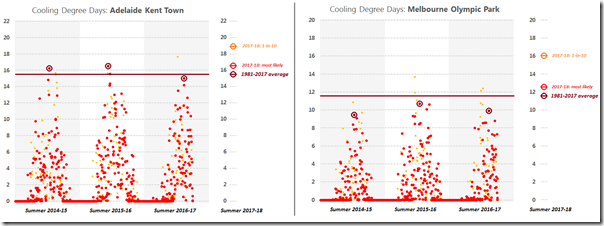The Bureau of Meteorology’s latest ENSO Outlook has activated a La Nina watch, indicating a 50% to 70% chance of a La Nina event developing during this upcoming summer. This would be the first La Nina event since the back-to-back La Nina summers of 2010-11 and 2011-12.
La Nina events often (but not always) suppress extreme heat across Australia’s eastern states, due to the lack of westerly winds that send the Interior heat eastward to Brisbane and Sydney. Instead, sea breezes tend to easily set up across coastal Queensland and New South Wales during the mid-to-late afternoon summer hours, thus often suppressing temperatures through the critical hours of peak demand. This pattern would be in stark contrast to recent summers, where both Brisbane and Sydney were frequent targets of extreme temperatures.
With the knowledge of La Nina-like conditions developing during the upcoming Summer 2017-18, I thought it might prove valuable to reflect on the climatology of heat waves in the southern states, for two reasons:
(1) The last 3 summers vs. climatology: The most recent three summers saw only middle-of-the-road heat events, particularly in Melbourne. The hottest days also often occurred on weekends or holidays. Thus, it’s a good time to reflect on the actual climatology of extreme heat in the southern states, and what we should be prepared for.
(2) The Summer 2017-18 Forecast: While extreme heat events are likely to be suppressed for east coast cities due to the predicted La Nina-like conditions, the same cannot be said for the southern states. We will need to keep watch for southern NEM heat waves this summer.
PREDICTING PEAK DEMAND USING COOLING DEGREE DAYS
While it is well known that peak daily demand is highly correlated to temperatures, it may be less known that it can be better predicted using Cooling Degree Days, rather than using only daily maximum temperatures.
Cooling Degree Days (CDDs) are frequently used internationally in order to help quantify the amount of demand for energy needed to cool a home or business. The daily CDD value is calculated by taking the average of that day’s minimum and maximum temperature, and subtracting it by 18 degrees. Negative values are bounded to zero.
In other words, the Cooling Degree Day index assumes that there is a linear relationship between a day’s average temperature and its peak demand, for days with an average temperature above 18 degrees. While far from a perfect relationship, the correlation produces a good first-order estimate for the temperature’s effect on summer energy demand.
By looking at historical CDD values for a particular city or region, we are able to gain some valuable insights on how historical weather patterns would translate into peak demand today.
ADELAIDE
Looking back at CDD values from 1981 to 2017, the highest daily CDD value during a given summer (ignoring values on weekends and holidays) is usually around 15 to 16 CDDs. Given the correlation between CDD values and peak demand, a day with a CDD value of 15 to 16 would require approximately 1400-1500 MW of additional electricity during the time of peak demand, purely due to the cooling of homes and businesses.
However, every 1 in 10 years, Adelaide is expected to have at least one summer workday that reaches 18 cooling degree days. This extreme would require an additional 250 MW of electricity vs. a more typical hottest day of summer.
Furthermore, there is a pronounced warming trend over recent decades with respect to extreme heat in Adelaide. Using a simple linear trend, this summer’s adjusted climatology would suggest a most likely value of 16 to 17 CDDs, with a 1-in-10 chance of a day registering at 19 CDDs.
Looking at the last ten summers in Adelaide, we can clearly see the heatwaves of January 2009 and January 2014, registering as streaks of daily CDD values between 17 and 21. More recently during the last three summers, daily CDD values have peaked closer to the long-term norm.
However, the most noteworthy fact of this graph: Even though last summer’s hottest days in early February proved critically hot for the South Australia electricity grid, last summer was the only summer in the last 10 years to have its peak workday CDD value fall below the long-term average – 15.0 CDDs on 9 February 2017 vs. the long-term average of 15.5 CDDs.
Also worth noting: the highest CDD value last summer was on 7 January – a Saturday. Had it fallen on a weekday, this may have instead proven the day of peak demand last summer, and serves as a reminder that the heat seen in early February 2017 is relatively common, and serves more as a typical summer peak rather than an extreme one for Adelaide.
MELBOURNE
Using a 1981-2017 climatology, Melbourne typically sees a peak value of 11 to 12 CDDs in any given summer, when excluding weekends and holidays.
This translates to roughly 2700 to 2900 MW of additional electricity demand during peak hours, purely due to the use of air conditioning and cooling devices. The 1-in-10 year value for Melbourne is 15 cooling degree days. Using the approximate linear relationship between CDD values and peak demand, we’d expect an additional 700 to 800 MW of energy demand during 1-in-10 year hot day vs. a typical hottest summer day.
A similar multi-decadal warming trend is in the data for Melbourne, and thus an extrapolated 2017 climatology would be around 12 to 13 CDDs, with a 1-in-10 year peak of 16 CDDs.
The most recent three summers have all seen peak demand below the long-term average, which is even more pronounced when considering the warming trend of extreme heat in Melbourne.
It is also important to note that the last three summers’ suppressed peak demand in Melbourne were partly due to the hottest days falling on weekends and holidays, thus not translating to extreme electricity demand. The hottest day of the summer typically falls on a weekend or holiday only 40% of the time, thus the frequency of extreme heat missing the workdays over the last three summers is an anomaly rather than the norm.
SUMMER 2017-18 vs. the previous three summers
A forecast for Summer 2017-18 can be made by using CDDs as a proxy for peak demand, and assuming an adjusted climatology as the best forecast for the upcoming summer.
Adelaide’s most likely peak demand this summer will be in the vicinity of peak demands of the previous three summers, with the added knowledge that a 1-in-10-year hot workday would result in demand approximately 250MW above the peaks of recent summers.
Melbourne is quite a different story however, with recent summers falling below the long-term trend, and well below the adjusted climatological mean value of 12.5 CDDs. This alone implies that this summer’s peak demand will most likely come in about 400 MW higher than the typical peak demand values of the last three summers. However, of more concern is the 1-in-10-year value of 16 CDDs. The resultant peak demand is estimated to be 1100 to 1200 MW above the peak demand values of recent summers.
This likelihood of higher peak demand than in recent summers is further exacerbated by the slightly increased chance of Adelaide-Melbourne combination heat that can come with La Nina summers.
A common mechanism for southern NEM extreme heat during La Nina events is for northerly wind flows to send Interior heat into Adelaide and Melbourne, in the wake of slow-moving high pressure systems that can occasionally stall in the Tasman Sea. This setup has the ability to give heat to both Adelaide and Melbourne at the same time, and often for more than one day in a row.
Equally important to note is the tendency for wind power generation to be both low and on the decline through the afternoon hours during these types of setups.
About our Guest Author
| Rob Davis is a Meteorologist who has worked with MetraWeather since December 2013 – and prior to that for many years with The Weather Network.You can find Rob on LinkedIn here.
MetraWeather is a world leader in the supply of weather data visualisation and automated prediction technology solutions to energy, broadcasting, retail and other industry clients around the globe. MetraWeather works with clients throughout the energy supply chain, providing specialised software, dependable high-quality forecasts and observational data designed to give customers the essential insights necessary for them to make timely and effective business and trading decisions. |








Nice to read a really high academic quality article – thank you. Only at the end do you mention what I think is the event that will cause the greatest trouble and that is when Adelaide and Melbourne are both extra hot. This is where better demand side management would help. And, by better I mean more carrots and less sticks.
If I read this correctly there is a reasonable chance that Victoria’s peak demand could reach 10-10.5 GW. Total despatchable capacity including VIctoria’s share of the Snowy is 9GW. maximum imports from Tassie, 500 MW which leaves 1 GW to be provided by demand response (150MW likely) local wind and solar (500MW possible) lmports from NSW zero, imports from SA possibly 350MW. reserve margin zero.
Very interesting. The energy balance that Peter Farley makes is very interesting. The whole SA issue depends on probabilities of demand and generation events. The first is that Vic and SA demands are highly correlated. AEMO has summarised the outlook in terms of SA demands, plant failures in Vic (not in these terms) and limitations in solar and wind resources. One issue is that this is fine for one day and all going well but if you get a series of very hot days, then it only requires a couple of these and a plant event to make for a potential loss-of-load event. Any flaws in this logic